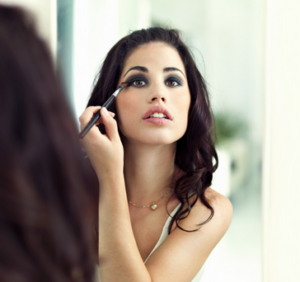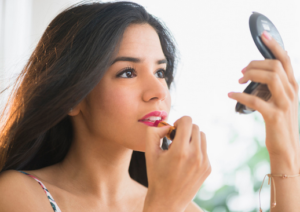Are your beauty products making you sick? When in doubt …
By Susan Burke March
Personal care products and cosmetics have the potential to harbor bacteria. Chemicals meant to protect you break down over time and are rendered ineffective, or worse, potentially irritating or infectious. Maybe you have some old favorites sitting in your makeup bag, but how old is too old?
some old favorites sitting in your makeup bag, but how old is too old?
It’s time for some spring-cleaning. Toss out the old in favor of new, safer products.
Moisturizers, Body Lotions, Foundation
The way your cream is packaged can make the difference between safe or risky. Dispensers that limit air and light are safe — pump dispensers and squeeze tubes — but creams in jars can be risky. Every time you open the jar and stick your fingers in to grab a dab, there’s an opportunity to introduce bacteria. The same for foundation — buy makeup in pump bottles (in the small size) that dispense only what you need.
Eye makeup
Don’t share your eye makeup, unless you want to share your germs. Liquid eyeliner is good for up to a year, but eye liner and eyebrow pencils are stable for many years — with the exception if the tip gets white or gray, it is a sign of mold. Sharpen your pencils frequently. Once opened, mascara is good for about three months, then throw it out.
 Makeup sponges
Makeup sponges
Reusable sponges and makeup brushes for applying foundation and blush are notorious for harboring bacteria — dermatologists advise not reusing sponges at all — either use clean fingertips to apply your foundation, or wash your sponges and brushes thoroughly with soap and water after each use, and air-dry.
Personal Care Products: Avoid These Chemicals
Makeup, shampoo, soap, toothpaste, sunscreen, hair products, moisturizers, deodorant, body lotions,baby products, feminine hygiene products — and much, much more — all have the potential to contain certain chemicals that can bio-accumulate and have toxic side effects.
I like the advice offered by PrecisionNutrition.com: “you don’t have to trash every item you’re currently using and overturn your bathroom overnight!” Instead, make changes progressively, and when it’s time to throw out an old product, replace it with a safer version.
Start by buying “fragrance-free.” What’s not necessarily safe are products labeled “natural” or “organic” or “pure” since the terms carry no legal standing. “Dermatologist-tested,” “non-irritating” or “hypo-allergenic” products are just marketing terms. According to Dr. Bruce Robinson, clinical professor of dermatology at New York’s Lennox Hill Hospital, there is no standard or board to confirm the claims.
Although this list of chemicals is not exhaustive, the following are the most offensive, and commonly found in products. Read the ingredient label and for more information, visit Environmental Working Group’s Skin Deep Cosmetic Database to learn more.
 Formaldehyde: in nail polish, body washes, hair products, eye shadows, and more — used to prevent bacterial growth — can cause allergic reactions and is a known human carcinogen.
Formaldehyde: in nail polish, body washes, hair products, eye shadows, and more — used to prevent bacterial growth — can cause allergic reactions and is a known human carcinogen.
Parabens: used to preserve and provide fragrance, parabens are known endocrine disrupters. Found in makeup, body washes, deodorants, shampoos, and facial cleansers.
Synthetic colors: for example, D&C Red 27 or FD&C blue 1 are derived from petroleum or coal dye — both are banned in the European Union.
Triclosan: an anti-bacterial agent found in some toothpastes, deodorants, and antibacterial soaps: because of the long-lasting effect on aquatic life and potential for creating resistant bacteria, its use is restricted in cosmetics in Japan and Canada.
Sodium lauryl sulfate (SLS) / Sodium laureth sulfate (SLES): a surfactant found in more than 90% of personal care and cleaning products (foaming products). SLS’s are known to be skin, lung, and eye irritants.
Oxybenzone: used in more than 50% of sunscreens as a UV light absorber, but may be an endocrine disruptor and cause photoallergic reactions. Japan restricts use in personal care products.
Toluene: a common solvent used in paint thinners, also found in moisturizing creams and nail polish. It’s a neurotoxin and pregnant women should avoid it (so should everyone).
Fragrance and Phthalates: Fragrances encompass hundreds of synthetic chemicals including phthalates — they are used to help hold color and scent in products. Since companies do not have to disclose these individual chemicals, it’s prudent to avoid “fragrances.”
Lead and other toxic ingredients: SafeCosmetics.org writes that there is no safe level of lead exposure, but it appears that just about all lipsticks on the market, some of the most popular and expensive ones, contain not only lead, but other toxic heavy metals, including chromium, cadmium, aluminum, manganese, and lead. Lead is linked to learning, language, and behavioral problems, reduced fertility in men and women, and hormonal and developmental delays and changes. It does not show up on the ingredient label: buyer beware.
There are options for safe shampoos, soaps, cleansers, even for some safer cosmetics, and you can make some products yourself at home. I’ll share more in my upcoming column on Safer Personal Care Products, and you can write to me at SusanTheDietitian@gmail.com to share your favorite home personal product recipes, or where you purchase your safe cosmetics and products here in Cuenca.





















